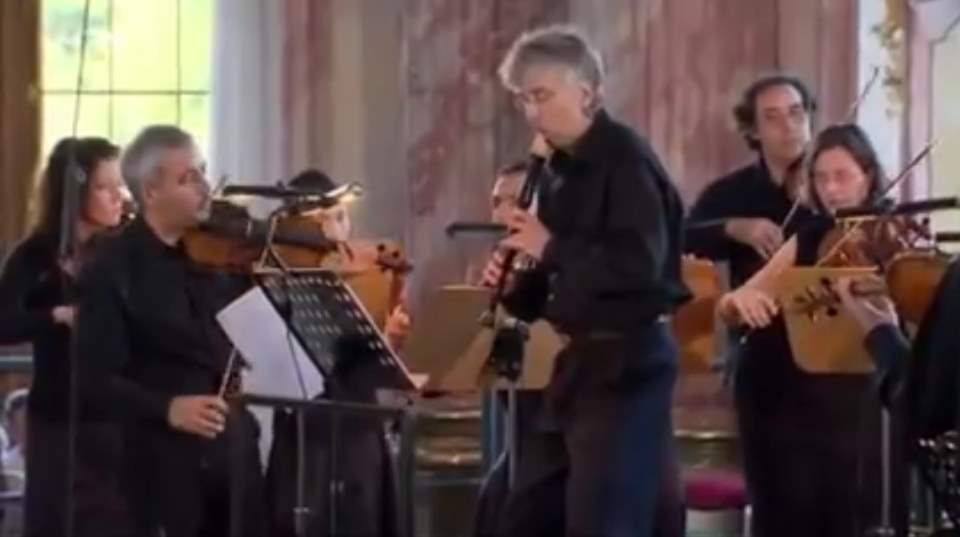Accompanied by the Italian chamber orchestra I Solisti Veneti, Irish virtuoso flute player Sir James Galway performs Antonio Vivaldi’s Flute Concerto No. 3 in D major, RV 428 “Il gardellino”. Conductor: Claudio Scimone.
Antonio Vivaldi’s Flute Concerto No. 3 in D major, RV 428 “Il gardellino”
Antonio Vivaldi’s Flute Concerto No. 3 in D major, RV 428, known as “Il Gardellino” (The Goldfinch), is a work that showcases Vivaldi’s exceptional skill in composing for the flute. Written in the Baroque era, a period characterized by ornate musical expression and complex harmonies, this concerto stands out as a delightful example of Vivaldi’s genius in creating vivid musical imagery.
The concerto, titled “Il Gardellino,” translates to “The Goldfinch,” and this is reflected in the music’s character. Vivaldi, known for his programmatic writing where music is intended to evoke scenes or narrate a story, imparts a vivid portrayal of a goldfinch’s chirping and the tranquil scenes of nature. The piece is an auditory painting, rich in musical textures and colors, inviting the listener into a pastoral world.
Vivaldi, a prolific Venetian composer and violinist, was adept at writing concertos, a form of music where an instrument (or a group of instruments) is featured soloistically, contrasting with and complemented by a larger ensemble. In “Il Gardellino,” the flute assumes the spotlight, engaging in an intricate dialogue with the strings and continuo. This interplay creates a dynamic and expressive texture, a hallmark of Vivaldi’s style.
The music’s charm lies in its ability to convey imagery and emotion through melodic and harmonic means. The flute, with its light and airy timbre, is perfectly suited to mimic the delicate and playful nature of a goldfinch. Vivaldi’s use of rapid scales, trills, and arpeggios in the flute line not only showcases the instrument’s capabilities but also paints a vivid picture of the bird’s swift and graceful movements.
The concerto’s overall mood is cheerful and buoyant, reflecting the Baroque era’s affinity for expressive contrasts and elaborate ornamentation. Vivaldi’s mastery in composing for the flute is evident in the way he navigates the instrument’s range and color, weaving a tapestry of sound that is both enchanting and technically demanding.
Antonio Vivaldi’s “Il Gardellino” is a flute concerto that stands as a testament to his brilliance in musical storytelling and compositional skill. Through its lively melodies and picturesque musical language, it captures the essence of a goldfinch in nature, offering listeners a delightful auditory experience that is both engaging and uplifting.
“Il Gardellino” is in three movements:
- Allegro
- Presto
- Allegro

The goldfinch, a small and colorful bird, is admired for its vibrant plumage and melodic song. Characterized by its striking red face, black and white head, and bright yellow wing patches, it presents a cheerful sight. These birds are found across Europe, North Africa, and western and central Asia. Goldfinches are social creatures, often seen in flocks, and are known for their fluid, twittering calls and songs.
Their diet primarily consists of seeds, making them frequent visitors to bird feeders. The goldfinch’s nest is a masterpiece of construction, small and neat, often built in the branches of trees. These birds hold a special place in cultural symbolism, representing joy and positivity, which is reflected in their lively nature and beautiful song.
Sir James Galway
Sir James Galway OBE (born 8 December 1939) is an Irish virtuoso flute player from Belfast, nicknamed “The Man with the Golden Flute”. He established an international career as a solo flute player. In 2005, he received the Brit Award for Outstanding Contribution to Music at the Classic Brit Awards.
![Accompanied by the Italian chamber orchestra I Solisti Veneti, Irish virtuoso flute player Sir James Galway performs Flute Concerto No. 3 in D major, RV 428 [Il gardellino] by Antonio Vivaldi](https://cdn-0.andantemoderato.com/wp-content/uploads/2016/02/James-Galway-Antonio-Vivaldi-Flute-Concerto-No-3-Il-Gardellino-1024x576.jpg)
Sources
- Six Flute Concertos, Op. 10 (Vivaldi) on Wikipedia
- James Galway on Wikipedia

Wonderful! Thank you.
You’re welcome, Vicki! Thanks for watching.